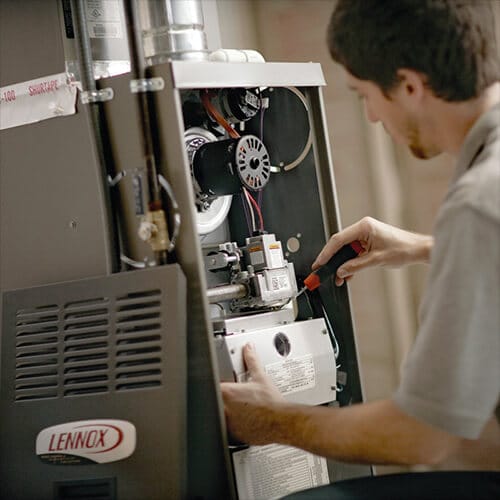How Do You Know What Size Furnace You Need?

Unfortunately, furnaces don’t last forever but have an expected service life of usually between 15 and 20 years. While it’s disappointing that you will have to reinvest in your furnace, at least it’s something you can plan to happen. When it is time to replace your furnace, you want to make sure you get the right size for your home. Here’s some information on why size matters and the variables to consider.
Understanding Furnace Sizes
The very first part of learning about furnaces is understanding how they are sized. When thinking about most HVAC systems, the size is measured in terms of BTUs, which stands for British Thermal Units. One BTU is the amount of energy required to raise one pound of water by one degree Fahrenheit.
Commonly seen among furnaces is also the use of the term tonnes, such as 10.5 or 11.3 tonnes. This is simply another way of referring to BTUs, with one tonne equaling 12,000 BTUs. So if you need a furnace that produces 92,000 BTUs, that’ll be about 7.7 tonnes.
Why Does Furnace Size Matter?
A furnace that produces more BTUs produces more heat at once, which may seem advantageous. Common logic would say that more heat production will warm your home more quickly, reducing your heating cycle length. However, this is an overly simple view of how furnaces work and can actually increase utility costs and the strain on your system.
When a furnace is oversized for the space it serves, it causes shorter heating cycles by quickly raising the air temperature. However, short heating cycles means the system is not circulating enough air to effectively heat your home. This leads to more frequent heating cycles, which means more strain during the start-up process and more energy used.
An undersized furnace is just as challenging as an oversized one. A unit too small for your space will cause it to run longer cycles, again increasing your utility costs and the strain on your system. This is why it’s so important to get the right size unit for your home. Here are the factors used to determine the right size unit for your home.
Calculate the Square Footage
You’re likely to see many people suggest that your home’s square footage is the way to determine your home’s heating needs. This is, in fact, the first step, but is not as easily calculated as you may think. In some cases, you may be able to use your home’s size from its last real estate listing. However, that may actually be over- or under-sized for what you require.
Rather than relying on your listing, take the time to calculate your home’s square footage. Go room by room and take measurements of the length and width of each room; then, multiply these together. This will give you the square footage for square or rectangular rooms.
For a circular room, measure straight across your room, then divide it by two to get the radius. You then square the radius and multiply it by 3.14. If you happen to have a triangular-shaped room, multiply the longest side of the room by the widest part of the room and divide by two.
Consider Uncommon Spaces
Don’t forget to include uncommon or commonly missed spaces in your home. Many people forget about hallways, bathrooms, the laundry room, and closets. All of these areas may seem small an inconsequential, but all add up quickly when thinking about square footage.
Next, look to see if you need to include areas that are not commonly serviced by a furnace. These areas may include your basement, attic, and garage. The best way to know whether you need to include them or not is to look to see if there are ducts with vents in those areas. Even if you keep the vents closed, be sure to include them when sizing a new furnace.
Convert Square Feet to BTUs
Next, you convert your total serviceable square footage into BTUs. The further away from the equator you are, the more BTUs you’ll need per square foot. The St. Louis area is in what’s considered Zone 3, which means about 40 BTUs per square foot.
You simply multiply your total serviceable square feet by 40. If you have a 2,300-square-foot home, you’ll need 92,000 BTUs. However, this is just a starting point, and there are several other factors to consider that may increase or decrease the size of your unit.
How Many People Occupy Your Home
You have to consider how many occupants you typically have in your home. Living creatures release heat, so that works in your favor when it comes to your furnace. If you have more than two occupants in your home, including pets, you may be able to reduce your furnace size.
Your installer will also consider when your occupants aren’t home and your home’s basic heating needs. This helps ensure you don’t over-stress your unit while your family is at school and work or away on a trip.
Home Construction
Several factors of your home’s construction will also play a role in the size furnace you require. Vaulted ceilings, number of windows, and number of ceiling fans may all change how much heat your furnace needs to produce.
Likewise, your home’s age and how well it’s sealed will affect how your furnace heats it. A newer home will likely be better sealed than an older one and will not need as much heating capacity to keep it at your desired temperature.
Type of Roof and Insulation
Your roof is also a major consideration for how your furnace will operate. First, you’ll need to consider the insulation in your attic, with the recommendation being R30 rating. Then, the kind of roof on your home will also affect how well it maintains its heat. The standard roofing material is asphalt shingles. Your furnace installer will need to take into consideration if you have nonstandard roofing material when sizing your unit.
Understanding Efficiency Ratings
Finally, you’ll need to consider the efficiency rating of the furnace you’re considering. Modern furnaces offer efficiency from the minimally required 78% to the low 90s for high-efficiency models. This is important because if you only look for a unit that is the bare minimum of what you require, you’ll likely have an undersized unit.
If the unit you’re considering produces 100,000 BTUs with an 80% efficiency rating, it will only service a space that requires up to 80,000 BTUs. Take that 96,000 BTU need we discussed earlier and let’s explore a high-efficiency model. To get an effectively sized unit, you’ll need something rated for about 103,000 BTUs at a 93% efficiency rating.
People around O’Fallon have trusted Hoff Heating & AC for superior heating and air conditioning service for more nearly 40 years. Our award-winning team provides expert heating and air conditioning installation, maintenance and service along with indoor air quality solutions. Call to schedule your consultation with one of our furnace installation specialists today.

 Call Us Today
Call Us Today
